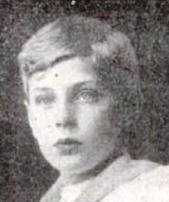Presents
George Szell
 |
 |
|
|
Picture of Szell about the time he wrote his quintet |
||
Piano Quintet in E Major, Op.2
George Szell (1897-1970) was born in Budapest, then part of Austria-Hungary. His original given name was Hungarian—György Endre Szél, In 1903, his family moved to Vienna and Germanized their names. György Szél became Georg Szell. In Vienna, Szell studied piano with Richard Robert (Robert Spitzer) and composition with Eusebius Mandyczewski, a personal friend of Brahms. In 1910, Szell enrolled at the Leipzig Conservatory, where he took further composition lessons with Max Reger and piano lessons with Robert Teichmüller. At the age of eleven, he began touring Europe as a pianist and composer. London newspapers hailed him as “the next Mozart.” At the age of 14, Szell signed a ten-year exclusive contract with the Viennese publisher Universal Edition. During his teenage years, he performed throughout Europe as a soloist, but also as a conductor. Despite his obvious pianistic and compositional talents, which were widely recognized, Szell decided on a career as a conductor, holding positions in Berlin, Prague, Dusseldorf and Darmstadt. With the advent of the Nazi’s rise to power, Szell decided to emigrate to the United States because, despite the fact that he had been brought him up as a Catholic, his family had originally been Jewish. He remained in the States for the rest of his life, eventually becoming an American citizen and Anglicizing his name to George from Georg. After teaching for several years at the Mannes Conservatory in New York, in 1946 he accepted the position as music director and conductor of the Cleveland Orchestra.
The Piano Quintet in E Major, Op.2 was completed in 1911 when he was 14 years old while studying at the Leipzig Conservatgory. It is without question an amazing feat for a 14 year old, clearly showing that he was a compositional prodigy of the first rank. It is no wonder that Universal Editions offered him a ten year contract. Although the Quintet was written in a post-romantic style and completed while Szell was studying with Reger at the time, it does not sound anything like Reger, certainly not the Reger of 1910. The ideas almost certainly came to fruition during his Vienna days. The music is more akin to what composers like Gernsheim, Goldmark, Dohnanyi and Mahler were writing at the end of the 19th and beginning of the 20th century. In four movements, the first movement of the Quintet is simply marked Bewegt (animated) with nothing in standard Italian. The extraordinary main theme is lyrical, sweet and highly romantic. Hardly the sort of thing one would expect a 14 year old to write. The second subject, marked Sehr lebhaft (very lively) is just that. It picks up the tempo and is less saccharine. Tthere are frequent tempo changes throughout the movement. Next comes a Scherzo, playful, energetic and a little nervous. The trio section has the same tempo as the scherzo and is thematically very closely related to it. In the third movement, Mässig langsam (moderately slow), once again the music is highly romantic, something a lover might sing and not the sort of thing one would expect from a boy who was barely a teenager. The finale, Sehr lustig und ubermütig (very merry and full of high spirits) is played attacca after the third movement.
This is a first rate work from start to finish. A masterwork really. Had Szell continued composing and had not become such a famous conductor, this work surely would have entered the repertoire where it belongs. A great choice for concert.
Parts: $44.95